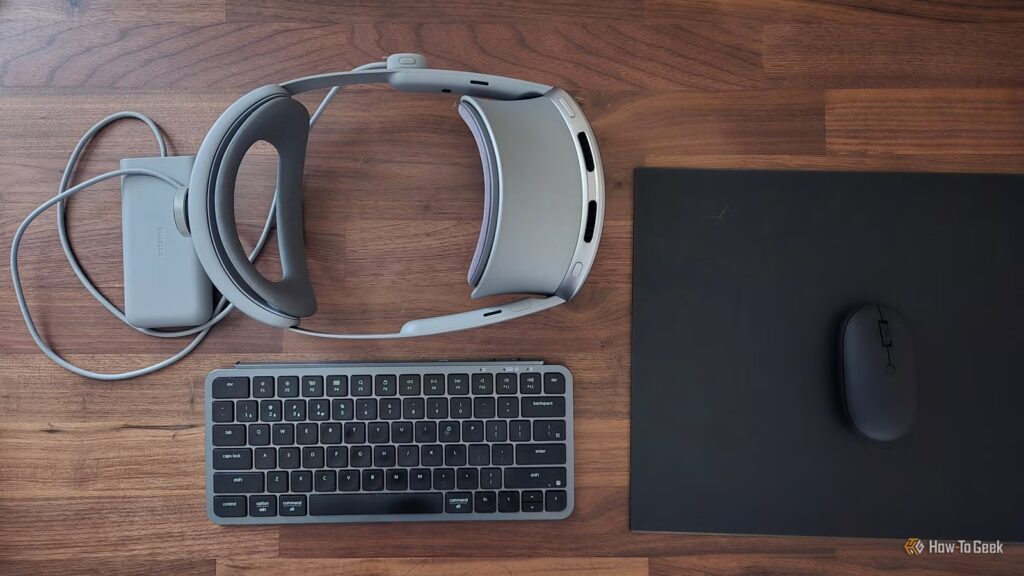Galaxy XR is the most expensive computer I’ve ever purchased, but it felt justifiable—not as a gaming machine, but for work. I wanted this headset not just because I write about Android, but because it’s the kind of workspace I can easily see myself writing in.
Galaxy XR provides access to all the software I need
I’m no stranger to unconventional work setups. Two years ago, I ditched my laptop and started using an Android phone as my primary PC. At the time, I connected my Moto Edge+ 2023 to a lapdock or external monitor and used Motorola’s Android-based desktop. I then bought an open box Samsung Galaxy Z Fold 5 and started using Samsung DeX instead.
Eventually, I found myself working directly on the foldable’s large inner screen and only occasionally fired up DeX. I fell in love with the malleability of Android, where apps adapt regardless of whether I’m using my device as a phone, tablet, laptop, or desktop PC. In a short time, my love of foldables and desktop modes had locked me into Android.
Galaxy XR is an independent and self-contained Android device. It comes with apps pre-installed and full access to the Play Store. Here is a headset that would be able to run all or most of the software I currently use. It’s the next frontier to explore with my Android-based workflow.
Resolution (per eye)
3552 x 3840
Display Type
Micro-OLED
Battery Life
2.5 hours
Processor
Snapdragon XR2+ Gen 2
Samsung Galaxy XR is a mixed reality headset and the first to ship with Android XR. It runs nearly all Android apps in addition to content specifically designed for XR and VR alike. With full Play Store access, the ability to sideload apps, and an unlocked bootloader, the Galaxy XR is the most open headset at the time of its release.
So I bought one, and I’m writing these words in augmented reality. I’m typing them in the PenCake app, which syncs with my phone. I have my outline open in Asana in a window hovering nearby. The Samsung Clocks app sits to the left, keeping track of my Pomodoro timer. Bandcamp sits farthest to the left, playing music from my collection since I haven’t yet copied over my folder of MP3 files to the headset’s 256GB of internal storage.
When I’m done writing, I’ll open Samsung Internet and format the article in How-To Geek’s web-based CMS. Samsung Internet is one of the best things about Galaxy devices, and I’ve already disabled Google Chrome like I do whenever I get a new Android device.
Extended reality provides me with a 360-degree workspace
I’m not a big fan of the conventional desktop paradigm. Taskbars generally strike me as wasted screen space, but hiding them feels like removing from the interface something that is assumed to be there. I’m not going to tell you that a traditional PC is a bad way to work. It’s functional, and in the absence of everything else, I’d happily go back. It clearly works well enough for most people working from a desk. But it doesn’t make my heart sing the way other forms of tech do. I prefer the design language of mobile devices, which unfortunately come with the limitation of having less screen space to work with.
Mixed reality headsets are, in a way, the best of both worlds. I have a design that’s even less cluttered than a phone (the time and status indicators are nowhere in sight), and I get the space to move windows around like on a desktop. Except in mixed reality, my canvas is neither flat nor limited to the area directly in front of me. I can actually just put apps wherever I want them to be.
This is much better for my posture
One of my favorite things about working in augmented reality is how much better it is for my posture. This is something I noticed when I first tried using AR glasses to replace my desktop monitor. I don’t have to give any thought to whether my screen is eye level. My display instead happens to be wherever my eyes are looking. I can hold my head at a healthy angle, and if I need to move for comfort, my “screen” moves with me.
The benefits are even more noticeable when I take a break from writing. If I need to watch a video or hop on a video call where I’m primarily just observing, I can lie down or sit back on the couch. The placement of the adjustment knob on the back of the Galaxy XR isn’t ideal for lying flat on my back, but I still find it more comfortable than remaining seated at my desk for yet another hour.
Credit: Bertel King / How-To Geek
A headset can be a primary PC
Galaxy XR comes with 256GB of internal storage and 16GB of RAM. The Snapdragon XR2+ Gen 2 processor inside is a variant of a mobile chip that, for the most part, is overkill on phones. So far, I haven’t encountered any lag or stutters to suggest it can’t handle the high-resolution display in Galaxy XR. The experience has been buttery smooth.
With full access to the Play Store, the ability to sideload any Android app from external sources, and a USB-C port for connecting accessories, Galaxy XR is just as open as the phones and tablets I’ve worked on over the years. It may look different from any other PC that’s sat on my desk, but it’s fully equipped to serve as my next one.
I’m on my fourth day of working via my Galaxy XR headset, and so far so good. Every issue I experienced in my previous passes at AR (such as when I reviewed the XREAL Beam Pro for MakeUseOf) is not present here. I’m happy to say it’s looking like this experiment may just work out, but you’ll hear it here if it doesn’t.

